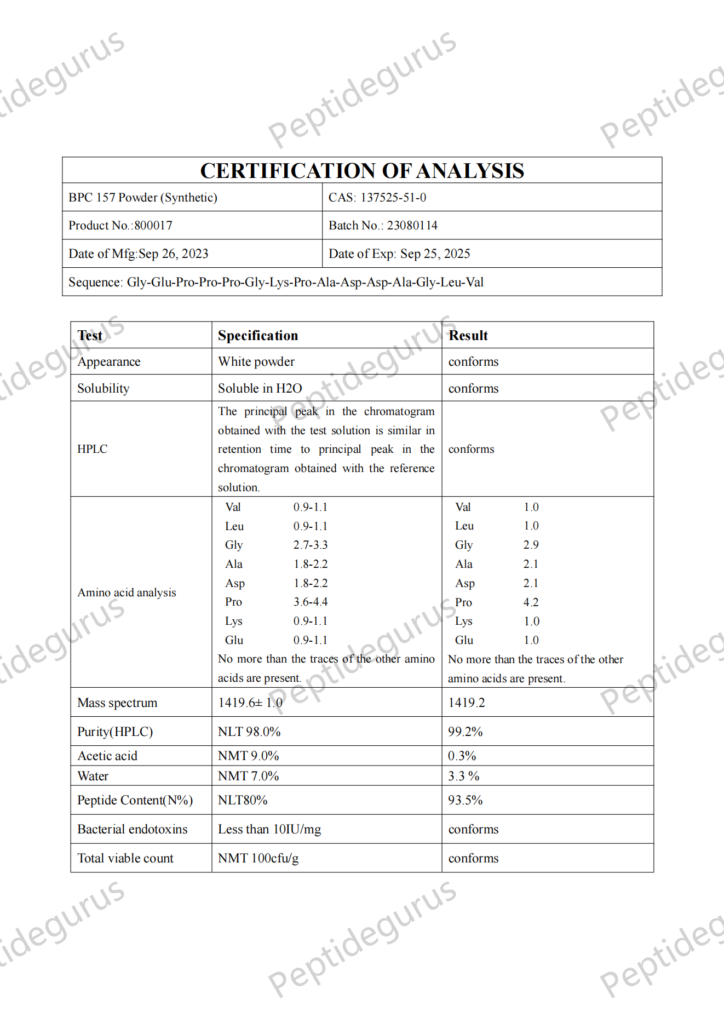




Categories: Peptide Blends
PotentialBPC-157 and TB-500Synergy in WoundRepair
Research reveals that BPC-157 and TB-500, which both help to stimulate wound healingvia different biochemical pathways, may have synergistic effects when combined together.
Cell Migration
Successful wound healing depends on fibroblasts, which regulate extracellular matrix production, as well as cells of the immune system. For these cells to do their jobs, theyneed to move to the location of injury. This movement, called migration, is heavily dependent the protein actin. Both BPC-157 and TB-500 are important in actin regulation BPC-157 works at the level of the gene to increase actin production[1].TB-500, an actinbinding protein, helps to sequester actin in areas where it is most useful for buildingfilaments from actin to allow for cell movement[2]. Together, BPC-157 and TB-500 worksynergistically to increase the quantity and function of actin and thus increase the rate atwhich fibroblasts and cells of the immune system migrate to areas of injury.
The Big PictureInvolves GrowthHormone
Both TB-500 and BPC-157 interact with growth hormone in the healing process. BPC-157increases the expression of growth hormone receptors on fibroblasts, boosting thelongevity of these cells and thus their ability to promote soft tissue regeneration[3]. WithTB-500 on board, the extra growth hormone receptors will not go to waste because thefibroblasts will have adequate stores of actin to make use of their elongated lifespans.Combining TB5-00, BPC-157, collagen, and a growth hormone secretagogue is a surefireway to increase rates of wound healing and may one day replace standard treatmentregimens as the gold standard.
About The Author
The above literature was researched, edited and organized by Dr. E. Logan, M.D. Dr. ELogan holds a doctorate degree from Case Western Reserve University School ofMedicine and a B.S. in molecular biology.
Scientific Journa Author
Allan L. Goldstein, MD, Allan L. Goldstein is professor and Catharine B. & WiliamMcCormick Chair of the department of Biochemistry and Molecular Biology at TheGeorge Washington University School of Medicine and Health Sciences, where he hasserved since 1978. Thymosins were discovered in the mid 1960’s, when Allan Goldsteinfrom the Laboratory of Abraham White at the Albert Einstein College of Medicine in NewYork studied the role of the thymus in development of the vertebrate immune system. Heis a world-renowned authority on the thymus gland and the workings of the immunesystem, and co-discoverer of the thymosins. Dr. Goldstein is the author of over 400 scientific articles in professional journals, the inventor on more than 15 U.S. Patents, andthe editor of several books in the fields of biochemistry, biomedicine, immunology andneuro-science. He is on the editorial boards of numerous scientific and medical journalsand has been a consultant to many re-search organizations in industry and government;,co-founder of The institute for Advanced Studies in Aging and Geriatric Medicine, a non-profit research and educational institute; a member of the Board of Trustees of the AlbertSabin Vaccine Institute, and serves as the Chairman of the Board of Regene Rx Biopharmaceuticals. Dr. Goldstein received his B.S. from Wagner College in 1959 and hisM.S. and Ph.D. from Rutgers University in 1964. He served as a faculty member of theAlbert Einstein College of Medicine from 1964 to 1972, and moved to the University ofTexas Medical Branch in Galveston in 1972 as professor and director of the division of Biochemistry.
Allan L. Goldstein, MD is being referenced as one of the leading scientists involved in theresearch and development of TB-500 and other Thymosins. In no way is thisdoctor/scientist endorsing or advocating the purchase, sale, or use of this product for anyreason. There is no affiliation or relationship, implied or otherwise, between PeptideSciences and this doctor. The purpose of citing the doctor is to acknowledge, recognize.and credit the exhaustive research and development efforts conducted by the scientistsstudying this peptide. Dr. Goldstein is listed in [5]under the referenced citations.
Resources
1.C.-H. Chang, W.-C. Tsai, M.-S. Lin, Y-H. Hsu, and J.-H. S. Pang, “The promotingeffect of pentadecapeptide BPC 157 on tendon healing involves tendon outgrowth,cell survival, and cell migration,”J.Appl. Physiol., vol. 110, no.3, pp.774-780, Oct[Physiology.org]
2.J. Kim and Y. Jung, “Potential Role of Thymosin Beta 4 in Liver Fibrosis,” Int. J.Mol. Sci., vol.16,no.5,pp.10624-10635,May 2015.[NCBI]
3.C.-H. Chang, W.-C. Tsai, Y.-H. Hsu, and J.-H.S.Pang,“Pentadecapeptide BPC157 enhances the growth hormone receptor expression in tendon fibroblasts,” Mol.Basel Switz.,vol.19,no.11,pp.19066-19077, NOV. 2014.[NCBI]
4.Song, Ran & Choi, Hyun & Yang, Hyung-In & Yoo, Myung & Park, Yong-Beom &Kim, Kyoung.(2012).Association between serum thymosin B4 levels of rheumatoidarthritis patients and disease activity and response to therapy. Clinicalrheumatology.31.1253-8.10.1007/s10067-012-2011-7.[Research Gate]
5.Philp, D., et al. “Thymosin β4 Promotes Angiogenesis, Wound Healing, and HairFollicle Development.”Mechanisms ofAgeing and Development, vol. 125, no. 2Feb.2004,pp.113-115,10.1016/i.mad.2003.11.005.[PubMed]
ALL ARTICLES AND PRODUCT INFORMATION PROVIDED ON THIS WEBSITE AREFOR INFORMATIONAL AND EDUCATIONAL PURPOSES ONLY.
The products offered on this website are furnished for in-vitro studies only. in-vitro studies(Latin: in glass) are performed outside of the body. These products are not medicines ordrugs and have not been approved by the FDA to prevent, treat or cure any medicalcondition, ailment or disease. Bodily introduction of any kind into humans or animals isstrictly forbidden by law.
PeptideGurus is a leading supplier of American-made research peptides, offering top-quality products at competitive prices. With a focus on excellence and customer service, they ensure a secure and convenient ordering process with global shipping.
CONTACT